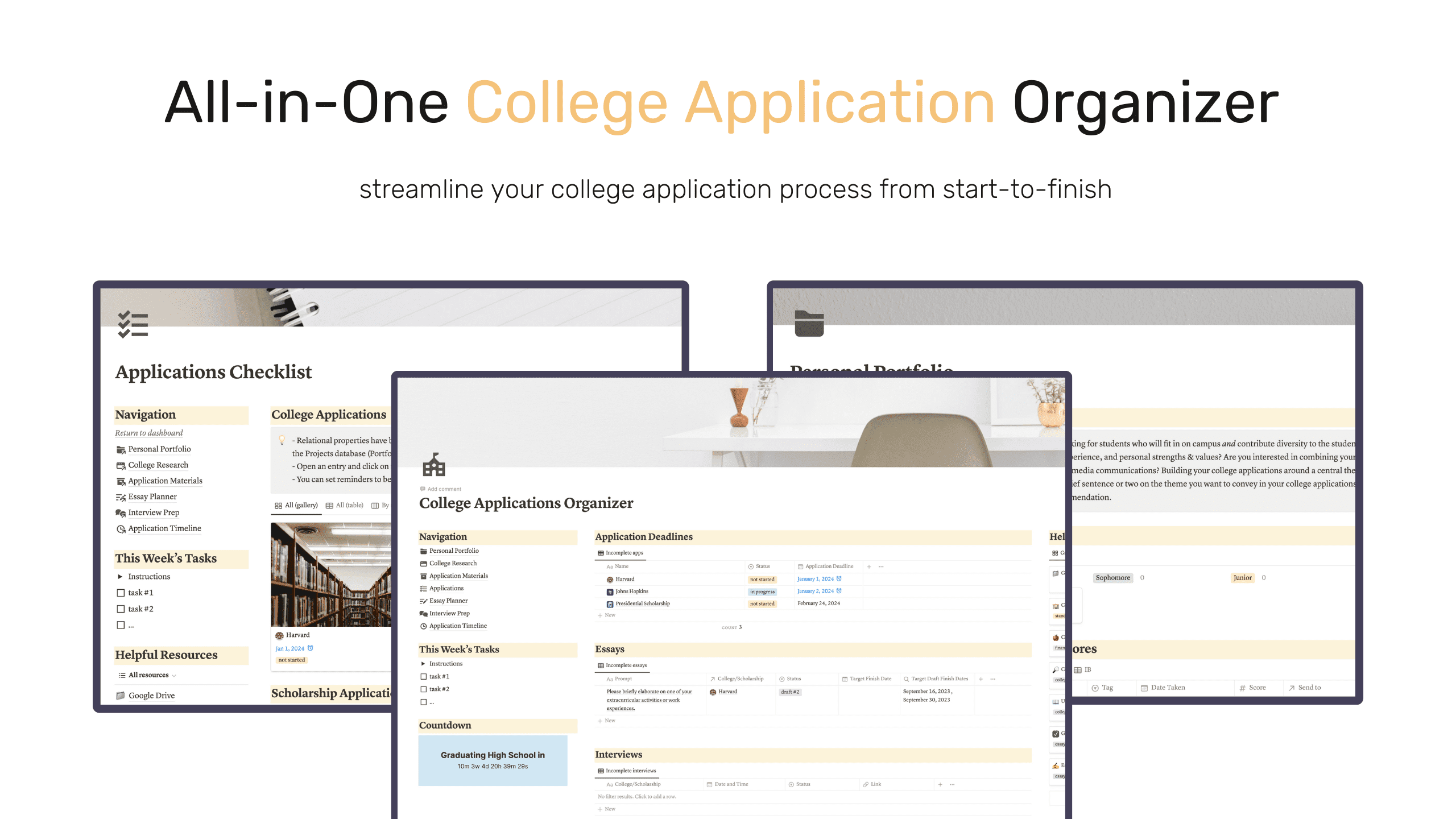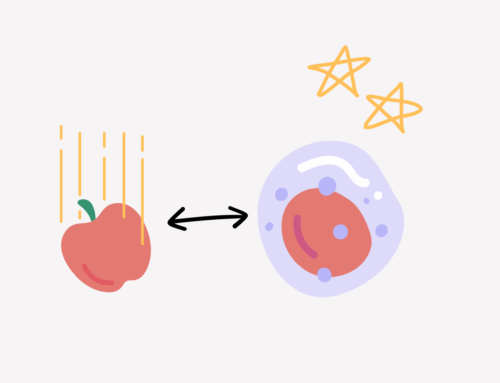
Picture this: your college applications are due in a few months, but there are so many components involved that you feel completely overwhelmed and confused. Where do you start? How do you keep track of everything?
If this sounds like you, then you’ve come to the right place! Having been through the college application process not so long ago, I know how complex it can all seem. However, by breaking the process down into actionable steps, it’s possible to stay organized and avoid unnecessary stress.
That’s why I created this college application timeline for seniors, which covers everything you need to do from the summer before senior year through each month of this pivotal period. By following this timeline, you can ensure that you won’t forget any materials and will be able to put together well-thought-out college applications.
Let’s dive in!
When Should A Senior Start Applying for College?
The simple answer is: the earlier, the better. By starting early, you give yourself more time to put together well-thought-out application materials and save yourself from stress down the road.
As a high school senior, you should begin your college planning journey the summer before the school year starts. This is the perfect time to kick-start your preparations because you’re not inundated with schoolwork and can dedicate quality time to research, self-reflection, and strategizing.
Use your summer to explore different colleges and universities. Dive into their websites, attend virtual tours, or even visit campuses if you can. Get a feel for the kind of institutions that align with your interests, goals, and values. Having a clear vision of your ideal college environment will help you put together more cohesive and thorough college applications.
Also, you should use this time to start brainstorming essay topics and jotting down experiences that reflect your strengths, passions, and values. The more you get done in the summer before, the less stressed you’ll be once the school year starts.
Okay, now it’s finally time to get into the college application timeline for seniors!
Summer Before Senior Year
Task #1: Explore Majors and Career Paths
Although you can delve right into doing college research, first looking into different fields of study and potential career paths can be helpful.
This will help you narrow down your college list. For instance, if you’re interested in biomedical research, you can then look for colleges with the top biomed programs.
Task #2: Research Potential Colleges and Universities
Plenty of websites offer tools for streamlining college research. These include:
- Big Future is run by College Board and provides a variety of tools to help with college planning. These include tools for matching colleges to your personal profile, guidance on selecting majors, and information on financial aid and scholarships.
- Unigo offers college reviews, rankings, and insights from current and former students. Like Big Future, it also provides information on financial aid and scholarships.
- You probably already have a Naviance account associated with your school. Naviance is a good tool for college research and career exploration. Plus, it provides stats on past acceptances at your school, which may be helpful in determining whether a specific college is a safety, match, or reach school for you.
- U.S. News & World Report ranks colleges and universities based on various factors such as academic reputation, graduation rates, and faculty resources. It may help you in finding colleges with strong programs in what you’re planning to study. Visit their websites, explore their academic programs, and delve into their campus culture. Get a sense of what makes each institution unique and whether it aligns with your aspirations and preferences.
Once you have a list of colleges that you’re interested in, you should narrow down your list further. Here are some ways to delve deeper into college research:
Create a Spreadsheet to Organize Colleges of Interest
Create a spreadsheet to keep track of the colleges you’re considering. Include columns for important factors like location, size, academic programs, and campus culture. This way, you can easily compare and contrast schools to make more informed decisions.
Attend Information Sessions
Many colleges now offer virtual information sessions. Once you sign up, you’ll be able to attend a live meeting held by representatives and/or students from the college. You’ll get to learn about campus culture, academic requirements, housing, extracurriculars, and other aspects of student life.
Additionally, you can ask your own questions to learn more about what a college has to offer.
Schedule Campus Visits and Tours
If possible, you may also want to plan some campus visits and tours. There’s nothing quite like stepping foot on a college campus to experience its atmosphere and visualize yourself as a student there.
You’ll be able to get a better feel for the campus culture and engage with current students.
Task #3: Register for Standardized Tests
As a high school senior, you’ve probably taken the SAT and/or ACT previously. However, if you’re not happy with your scores, now’s the time to register for these exams and improve your scores. (See this post for step-by-step SAT reading section tips!)
Use the summer to identify areas of improvement and take practice tests. For more rigorous preparation, you may want to consider signing up for test prep courses or tutoring.
During the school year, you’ll have classes to attend, homework to do, and of course, college applications to work on. Doing your standardized test prep over the summer will save you from a lot of stress when the school year rolls around.
Task #4: Engage in Extracurriculars and Leadership
During the summer, you should continue pursuing your extracurriculars and take on leadership roles if possible. Participate in internships, competitions, or summer programs to expand your expertise.
Also, consider leading your own community service initiative or engaging in some other activity that demonstrates your leadership skills. If you have the chance to apply for a leadership position in a school club or other organization in the upcoming year, take steps to prepare for the upcoming application or election.
Task #5: Begin Drafting Personal Statements and Essays
Writing college application essays is very time-consuming. Trust me, you do not want to wait until the school year starts to begin working on these. The essay writing process requires a lot of planning and introspection, and you’ll likely end up writing multiple drafts of most essays.
To get a headstart, take a look at the Common App prompts, as well as supplemental essays for colleges you’re applying to. Start brainstorming ideas and drafting your essays.
Task #6: Research Scholarships and Financial Aid
College can be costly, but scholarships and financial aid can make a world of difference. It’s therefore essential to research available scholarships and financial aid options early on.
Many of the websites I listed under “Research Potential Colleges” also provide scholarship search tools to help you get started.
Task #7: Create a Master Timeline
This is one of the most important steps of the college application process that is frequently overlooked! If you don’t want to be overwhelmed by all the different deadlines and required materials, you must create a master timeline.
Organize all of your deadlines in one place: deadlines for college applications, scholarship submissions, financial aid forms, supplemental portfolios, and other necessary materials. Also, make sure to set artificial deadlines for completing specific steps of the college application process (e.g., writing essays, creating an extended resumé). You do not want to leave things for the last minute!
If you’re not sure how to create an organizer, I’ve created a comprehensive college application organizer that will enable you to keep track of all deadlines and streamline the college application process in one place! This planner provides templates to do all the items listed in this section: college research, taking notes on information sessions, keeping track of standardized test dates and scores, engaging in extracurriculars, writing essays, and doing scholarship search.
September – October of Senior Year
We’re now entering the first stressful phase of the college application timeline for senior year. This is when you’ll need to decide what colleges to apply to and start putting together your college application materials.
Task # 1: Finalize Your College List
It’s best to narrow down your college list before the end of the summer. However, if you haven’t finalized your list yet, now is the time.
Based on the research you’ve done, create a college list with a well-rounded mix of reach, target, and safety schools. As a good rule of thumb, you should create a diamond-shaped college list with mostly match schools and a few safety and reach schools.
Task # 2:Work with Your Guidance Counselor
It’s essential to work closely with your guidance counselor during the college application process. Collaborate with them to refine your college list, discuss scholarship and financial aid options, and seek guidance throughout the application process.
They’ve already been through the process with countless other students, so they’ll be able to help you set realistic goals and aim for them.

Task #3: Consider Early Decision or Early Action Options
If you’re ready to commit to a specific college, Early Decision (ED) or Early Action (EA) options might be worth exploring. However, you must understand the requirements, deadlines, and potential benefits or restrictions associated with these early application paths.
If you apply ED, for example, your acceptance will be binding. You will not be able to apply to any other schools. If you apply EA, your acceptance will not be binding. Some schools, however, will only allow you to apply for Restricted Early Action (REA), in which case you can only apply early to that one school.
The early application policy for each college is different, so make sure you understand what you’re committing to when you apply early.
If you choose to apply by an early deadline, you need to put together your application(s), as most early applications are due in early November.
Task #4: Keep Up with Academics and Extracurriculars
Yes, colleges do consider your senior year academic performance and extracurricular involvements. As in any other year of high school, it’s important to maintain the rigor of your courseload, maintain your grades, and continue being involved in extracurriculars and community service.
If possible, strive to get chosen for officer positions in the clubs you’re involved in. This is a great way to demonstrate dedication, growth, and leadership.
Task #5: Take the SAT/ACT Again If Needed
If you’re not satisfied with your previous test scores, consider retaking the SAT or ACT. If you have a dream college, your SAT/ACT score should be at least at the 50th percentile or above for the admitted student body.
However, I wouldn’t recommend taking the SAT or ACT more than once during this period, as you’ll be busy with many other things.
Task #6: Request Letters of Recommendation
Reach out to teachers and mentors who can write strong letters of recommendation on your behalf. Ideally, you should have asked them before the summer to give them ample time, but if you haven’t, make the request now.
Many colleges require you to submit two recommendation letters from school teachers. However, you may be allowed to submit 1-2 optional recommendation letters from more school teachers or an outside mentor. If you’re submitting a supplemental portfolio, you may even be required to request a recommendation letter from an outside mentor.

Task #7: Draft Your Essays
Most applications are due between late fall and early January, so you need to work on your essays. If you’re applying to schools with a lot of supplemental essays, it can easily get overwhelming.
Therefore, it’s essential to set staggered essay deadlines for yourself to make sure you have ample time to draft, revise, and finalize all your essays.
Task #8: Gather Necessary Documents
Make sure to send your SAT, ACT, AP, and other standardized test scores to the colleges you’re applying to. Also, contact your guidance counselor to make sure you get your high school transcript delivered on time.
Follow up with teachers and mentors to make sure they’ve prepared your letters of recommendation and know where to submit them.
Task #8: Assemble Supplemental Materials
If applicable, assemble supplemental materials you believe will boost your application. You shouldn’t overwhelm admissions officers with materials, but some colleges may actually encourage you to submit materials such as:
- A supplemental portfolio that highlights your talents in a specific area (e.g., fine arts, writing, research, visual arts)
- An extended resumé highlighting achievements and activities beyond the limited space provided in the college application portal
Task #9: Fill Out the FAFSA and CSS Profile
Starting from October 1, you can fill out the FAFSA and CSS Profile to apply for financial aid. The FAFSA is known for being especially difficult to fill out, so you should get started on it early.
Task #10: Continue Looking for Scholarship Opportunities
You should continue searching for scholarship opportunities. Search online, inquire at your school, and explore local organizations that offer financial assistance. Every little bit helps!
Task #11: Stay Organized with a Planner
As always, it’s crucial to stay organized. With so much happening at once, you need to keep a college application organizer to centralize your materials, keep up with essays and other tasks, and submit your applications on time.
It’s easy to get overwhelmed during the college application process—I heard about classmates who forgot to apply to certain programs or put together supplemental portfolios because there were so many things going on. However, if you use a planner to organize materials and set short-term deadlines for tasks, you’ll be able to stay sane and in control during the college application process.
November – January of Senior Year
This period is (in my opinion) the most stressful phase of the college application timeline for seniors. This is when you’ll need to finalize all your materials and submit your applications on time. However, as long as you have a system for planning ahead and staying organized, you’ll be able to get through these months without being overwhelmed!
Task #1: Finalize College Essays
With deadlines approaching quickly, now’s the time to finalize your college essays. If you want, seek feedback from trusted individuals to revise and polish your essays.
Task #2: Organize and Revise Application Materials
Gather and organize all your application materials. Ensure you have everything you need, from transcripts to supplemental portfolios, test scores, an extended resumé (if applicable), and recommendation letters. Revise all your materials to ensure accuracy and clarity.
Task #3: Submit College Applications
After all the effort you’ve invested in the past few months, the time has finally arrived to submit your applications. Keep track of each deadline, and aim to submit before the cutoff to avoid last-minute technical glitches.
Task #4: Track Application Status
After submitting your applications, confirm receipt with each college (you’ll typically receive an email). You should now have access to a portal to track the status of your application. In the portal, you’ll be able to check which materials have been received. This is also where you’ll eventually receive your decision letter!
Task #5: Complete the FAFSA
If you haven’t done so already, complete the Free Application for Federal Student Aid (FAFSA). This is a crucial step in securing financial assistance for your college tuition.
Once you’ve submitted the FAFSA, keep an eye out for the Student Aid Report (SAR). The SAR is a summary of the information you provided on the FAFSA and contains important details about your eligibility for federal student aid. Make sure to review your SAR carefully and make any corrections if needed.
Task #6: Research and Complete Additional Financial Aid Forms
Check if any colleges require additional financial aid forms, such as the CSS Profile or institutional forms. Stay organized and submit them by the specified deadlines to maximize your financial aid opportunities.
Task #7: Prepare for Admissions Interviews
If you applied ED or EA, you may be scheduled for an interview in November or December. For RD applications, interview appointments may start rolling in by early January.
Prepare for these interviews by researching common questions, practicing your responses, and preparing your own questions for the interviewer. Check out this post for 10 common college interview questions and how to respond to them.

Task #8: Check Early Decision/Early Action Decision
If you applied ED or EA, keep an eye out for the decision notification. You’ll typically be notified in December.
If you’re accepted, it’s up to you whether you want to continue applying to other colleges or retract other applications you’ve submitted (unless you’re accepted ED—then, you’re not allowed to apply to any other colleges).
If you’re deferred, and that college is still one of your top options, consider sending a letter expressing continued interest and updates on your senior year to the regional admissions officer or another suitable representative.
February – March of Senior Year
It can be tempting to sit back and relax once you’ve submitted your applications. However, there are still a few important tasks you need to do before decisions are released!
Task #1: Continue Doing Admissions Interviews
You may continue receiving admissions interviews going into March. If so, continue preparing for your college interviews by practicing responses and preparing your own questions.
Also, make sure to follow up with interviewers to thank them for their time! Mention specific parts of the interview that you found memorable.
Task #2: Send Mid-Year Updates and Grades
Some colleges may request mid-year updates and grades to gain a better understanding of your academic progress. This means that you will need to continue maintaining your grades and involvement in extracurriculars.
If these materials are required, promptly submit them to provide the colleges with the most up-to-date information about your achievements.
Task #3: Look for More Scholarships
I know I’ve included this action item in every section so far, but that’s because there are tons of scholarships with deadlines scattered throughout the year. If you haven’t had a chance to apply to any earlier, you still have opportunities available.
Task #4: Consider Late Deadlines or Rolling Admissions
If, for whatever reason, you want to apply to additional colleges in February or March (this may be the case if you feel like you didn’t apply to enough safeties), then you have the opportunity to do so!
Some schools offer late deadlines or have rolling admissions, allowing you to apply late into the year. Research these options and consider if they align with your college preferences.
April – May of Senior Year
We’ve finally reached the home stretch of the college application timeline for senior year. At this point, your decisions should all be out, and you can start planning for college (and take a well-deserved break).
Task #1: Check Decisions
And finally for the moment you’ve been waiting for… college decisions! Most decisions are released by early April, so make sure to check your email and log in to your portal once a decision is released.
Task #2: Compare Financial Aid Packages
Review the financial aid packages offered by the colleges you’ve been accepted to. Assessing the affordability of an institution is an essential part of choosing which college to commit to.

Task #3: If You’re Waitlisted…
If you find yourself on the waitlist, you may be able to reach out to the college and inquire about ways to strengthen your application (this is not always the case, so check the college’s policies).
In many cases, you may not be able to reach out to the college directly, but you will be able to send additional materials, such as a letter of continued interest, another recommendation letter, senior year updates, and your end-of-year year transcript.
Task #4: If You’re Rejected…
Some colleges may allow you to send an appeal, presenting new information or addressing any concerns they may have had. Explore this option if you feel it’s appropriate for your situation.
Task #5: Visit Colleges Before Accepting
Before making your final decision, take the opportunity to visit the colleges that have accepted you. Many provide admitted student events, which is the perfect chance to get a feel for the campus, interact with current students, and gain valuable insights.
The college you commit to is where you’ll be spending your life for the next four years, so it’s important to get to know as much about the colleges you’ve been accepted to before making a decision. You may end up falling in love with a different college than the one you intended on attending, but you never know until you visit!
Task #6: Make Your Decision
After carefully considering the pros and cons of each college, it’s time to make your decision. Once you’ve chosen a college, submit the commitment form for that college. You’ll also need to inform every other college about your final decision by submitting their commitment form.
Next, you’ll need to send an enrollment deposit by the specified deadline to secure your space.
You should then contact your guidance counselor to send your final transcript, which is often required for enrollment. (As I’ve mentioned several times, colleges do look at senior year grades! In fact, some students get their acceptances withdrawn if their academics fall subpar in senior year.)
Task #7: Check for Final Grant/Scholarship Opportunities
Even this late into the year, there may still be some grant/scholarship opportunities.
Summer Before Freshman Year of College
You should enjoy yourself in the summer before college starts, but there are a few important tasks you shouldn’t overlook…
Task #1: Complete Enrollment Forms
Once you’ve enrolled, you’ll probably be inundated with a whole new set of deadlines. These may include orientation registration, course selection, housing applications, and placement test registrations. Make sure you submit everything on time to ensure your enrollment.
Task #2: Work-Study Job Search
Doing a work-study job is a great way to help pay for your college tuition. You should start your job search in the summer. Explore available positions on campus and apply for those that align with your interests and schedule.
Task #3: Buy College Materials
As you head into college, you’ll need lots of new materials. Not only will you need textbooks and school supplies, but you’ll also need to purchase a variety of dorm essentials. Luckily, many companies do offer student discounts to help reduce costs.
For inspiration on what to get for college, check out these posts:
- Student desk essentials to maximize storage in a small space
- Comprehensive list of college school supplies
- College backpack essentials for all your note-taking, organization, and personal needs
- Dorm essentials to make your living space comfortable and well-stocked
Task #4: Connect With Classmates, Current Students, and Alumni
You can start building connections within your college community in the summer. Reach out to classmates through social media or other communication platforms (many schools provide a private chat space for newly admitted students).
Also, connect with current students and alumni to gain insights, ask questions, and get a sense of what to expect. Their experiences and advice can help you with choosing courses, navigating social life, finding work-life balance, and more!
Task #5: Celebrate and Have Fun
Lastly, celebrate your achievements and have some fun. You’ve worked hard throughout high school, and this is one of the last opportunities you’ll have to not worry about schoolwork or extracurriculars.
If your college offers advanced placement exams, don’t stress too much about them. Colleges don’t want you to spend your summer learning material that you’ve never seen before in order to place in a more advanced class. Only plan to take advanced placement exams that you already know the material for.

FAQ
Do colleges care about senior year schedule?
Yes, colleges do care about your senior year schedule. Admissions officers want to see that you continue to challenge yourself by maintaining or increasing the rigor of your courses. The classes you choose (particularly post-AP, if your school offers them) also provide a good indication of your academic interests. So, it’s crucial to be thoughtful about your senior year course selection!
Do colleges care if your grades drop senior year?
Yes, colleges do care if your grades drop senior year. While they understand that senior year can be challenging with college applications and other commitments, a significant drop in grades may raise concerns.
You should maintain your academic performance throughout your senior year, as you’ll need to submit mid-year and end-of-year transcripts. Admissions committees want to see that you’re committed to your education and capable of handling the demands of college coursework.
What grade is best to start applying for college?
Most college applications open in the fall of your senior year, and that’s when you can start filling out your applications. However, it’s important to note that preparation for college applications should begin earlier, ideally in junior year. This is because the college application process is a long one, encompassing tasks like researching colleges, visiting campuses, and working on developing a strong academic and extracurricular profile.
Quick note: In rare occasions, students will apply for college in their junior year. See this article on applying for college as a junior for more details.
How many colleges should you apply to?
The number of colleges you should apply to depends on you! I know this isn’t a satisfactory answer, but it really is up to you. I know some students who only applied to 2 colleges and others who applied to over 22.
In general, however, you should strive to apply to a balanced mix of reach, target, and safety schools. While there is no specific magic number, 7-10 is a good range to shoot for. Applying to a range of schools allows you to have options and increases your chances of getting accepted into schools that align with your aspirations.
However, you also shouldn’t apply to too many, as you’ll likely be overwhelmed and not be able to optimize the quality of your applications.
Overview of College Application Timeline for Seniors
Following a well-structured college application timeline is crucial as a high school senior. There are lots of steps involved, so it’s essential to plan ahead, start early, and stay organized.
You can grab a free college application timeline checklist here to help you keep up with all essential tasks and milestones:
You can also check out my comprehensive college application organizer template here:
As someone who’s been through the college application process, I know how stressful it can be. However, remember that as you’re going through the process, you’re not alone. Seek advice from your guidance counselor, mentors, or other students when you need help.
Also, remember that while college decisions can be nerve-wracking, they don’t validate or invalidate the things you’ve achieved throughout high school, and they definitely don’t dictate your future path. College is just the first step, and ultimately, your unique talents, passions, and aspirations will guide you no matter what school you attend!
For more posts on college applications and high school success, check out:
- How to Start An Organization in High School in 4 Easy Steps
- How to Promote a School Club—11 Easy Ways to Attract Members
- Failproof Strategies to Answer Common College Interview Questions
- 7 Easy Steps to Start a Peer Tutoring Program as a Student
- Is An Internship An Extracurricular Activity + Other Extracurricular FAQs
- Most Impressive AP Classes (+ Useful Tips to Succeed in Them)

Learning With Angie is a place to share honest, unfiltered advice to promote student success. So if you’re a student (high school, college, or beyond) looking for tips on productivity, studying, personal growth, and more to reach your potential, this is the place! To read more about Learning with Angie, click here.


















